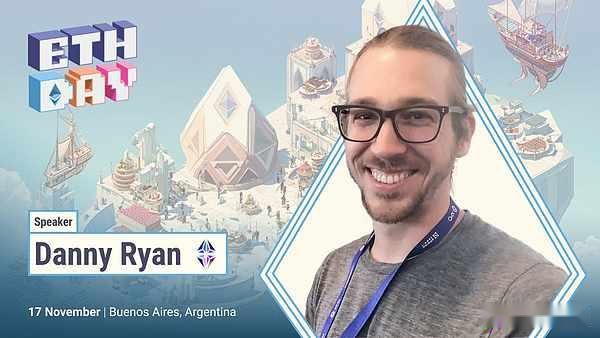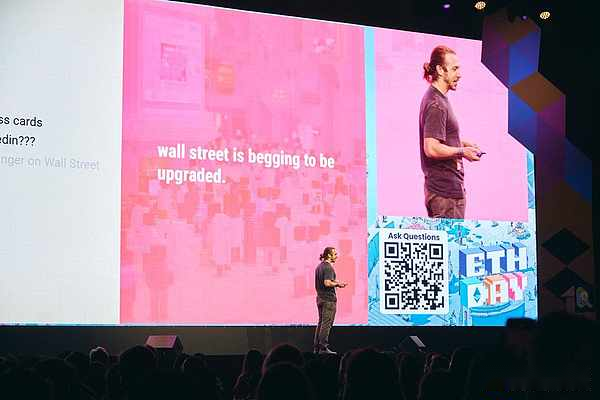
What surprised me the most was this: Wall Street actually has a strong need for decentralization.
This sounds counter-intuitive.We cypherpunks and crypto natives care about decentralization, but the public seems to be more inclined to install stablecoins or on-chain cryptocurrencies (meme coins).No one seems to care about this?But Wall Street cares.

Long time no see.I was absent from Devcon last time, and that was the only thing I could say about Ethereum at the time.
I have been working in the field of decentralized systems for the past few years, building Ethereum, researching mechanism design, decentralization, security and resiliency.Now, I deal with banks every day.It’s a little weird, but actually pretty funny.I learned a lot and they learned a lot from us.For example, I was surprised to find that business cards are still being used, and that everyone is using LinkedIn, even though I’m not on LinkedIn either (I’m pretty sure my coworkers aren’t too happy about that), but Wall Street still relies on these tools.
Speaking of Wall Street, in fact, “Wall Street” is no longer Wall Street.Except for the New York Stock Exchange, which is still there, most other institutions have moved to Artwork Midtown.
Current situation: Traditional financial markets are extremely inefficient
We usually think that the institutional market is very efficient. You may think that instant online trading is easy, but in fact it is efficient. Stock transactions take one day to settle (T+1), and this is already the most efficient.If you look deeper, the institutional market is filled with inefficiencies and a lot of manual steps.
The technical level is extremely fragmented.An asset manager might use one software to manage positions, another to do that, and a third to handle compliance, requiring complex integration between the software.It’s a Frankenstein-like sequence of disastrous software put together.Some agencies are even still sending faxes to each other.Settlement and other critical activities last too long.Settlement and settlement takes two days, which is still a “huge victory” from upgrading from T+3 to T+2 ten years ago.
In the world of Ethereum, transactions and settlements occur simultaneously. This is our inherent advantage.
Traditional systems are full of counterparty risk.The structure has been in existence for more than a hundred years, and its laws are imposed on the upper part, which is equivalent to placing additional emphasis on the middle people.From an anthropological perspective, it’s a miracle that they were able to build such a system.But now that we have better technology, it’s time to fix it.
Core Insight: Institutions are feasible and “craving” decentralization
What surprised me the most was:Wall Street (generally referred to as institutions) actually needs more decentralization.
This sounds counter-intuitive.We cypherpunks and crypto-natives are decentralizing each other, but it seems that the public is more concerned about installing stablecoins or rushing on the chain (meme coins).No one seems to care about this?But Wall Street cares.Let me “translate” the reasons for you through their perspective:
-
Eliminate Counterparty Risk:One perspective of institutional scoring is “Who’s going to screw me?” Risks exist at every layer, from counterparties to affiliated banks to infrastructure.The decentralization and Credible Neutrality of the infrastructure layer can greatly reduce or even eliminate this risk.
-
Uptime:This is crucial.They require 100% online rate.Ethereum is possible because there are a dozen clients and thousands of nodes running.This is not an accident, but a conscious design.
-
Scarcity Cryptoeconomic Security (Cryptoeconomic Security):There are only a handful of decentralized systems in the world that can carry the security of a “trillion-level” asset class.I am not referring to the hundreds of dollars of countless retail investors, but to the hundreds of billions of dollars in global assets across the country.You can’t just boot up a system tomorrow and have this level of security.Ethereum has this scarce resource.
-
Mature application layer:Ethereum has been running for ten years.If you talk to banks, as long as they understand a little bit about blockchain internally, it means EVM and Solidity.They need mature security standards and application standards, not tomorrow’s latest hot software.
-
Privacy (Privacy):This is something I value very much.Establishing privacy for institutions is the “Trojan horse” that drives the overall privacy narrative in blockchain.For institutions to adopt, privacy isAdmission Ticket (Table Betting), rather than cool features that are just icing on the cake.If privacy issues are not resolved, market upgrades will be impossible.When Institution A and Institution B trade, they cannot directly disclose their positions. This is against the laws of market operation.Fortunately, with the current $1 billion invested in Ethereum’s applied cryptography (especially zero-knowledge ZK), our investment in scalability (compression computation) has unexpectedly paid dividends in privacy protection.
-
Network effects and liquidity:Capital tends to flow to places where it is concentrated.With the mass adoption of stablecoins, Ethereum is far ahead in this regard.
-
Medium infrastructure (Tier 2):This is very important.When I explain Tier 2 to institutions, they really want to buy in.Banks want to build systems that can be customized and extensible, but that can be connected to Ethereum, the Internet of Value.
When you truly communicate with the organization in depth and complete the cognitive gaps, you will find:Wall Street needs Ethereum.
Real world vs speculative world
As a developer, it can get frustrating at times.You work hard to build an unstoppable, centralized system, but people are watching. Meme tokens issued by a multi-signature wallet controlled by “three people in the basement.”You worry that no one cares about decentralization.
But the institution’s need for centralization is actually a gateway toreal worldwindow.If it is just hype, people are indeed crucial; but if it is required to put pensions and real estate deeds on the chain, the real world willMandatory requirementsDecentralization.In these scenarios, breathing must be as safe as or even better than existing systems.
Strategy change: from “simple explanation” to “building better products”
The Ethereum community is very good at building infrastructure and mechanism design, but we need to move beyond the “build it and they will come” mentality.
We cannot simply explain to institutions why decentralization is needed.we needhypothesisGlobal assets are put on the chain.what to do?Not through simple tokenization;Build a system that is better than the existing system so that global assets must be moved to the upper chain.
Value collaboration can be divided into two stages:
-
Simply Better:Faster, cheaper, less trustworthy middlemen, and more user-friendly.
-
Extended Ecosystem:Asset simplification, DeFi composability, etc.
We tend to get too hung up on point 2, but we need to spend more on point 1.Although the current institutional products are elegant on the surface and powerful in reporting functions, they are still stuck in the Stone Age underneath.By leveraging blockchain features like atomic settlements, we can make products inherently better over time.Only by completing point 1 can we attract long-tail assets into the innovation field of point 2.
Successful easing: Trillion-level assets and market growth
We should be slow to succeed in units of “trillions.”There are currently approximately $18 billion in so-called RWA (Real World Assets) on Ethereum.By the way, if you talk to institutions, they don’t call it RWA, they call it “Assets”.The global asset management scale is estimated to be 120 trillion US dollars. If we want the global economy to be on the chain, we must use institutional capital.
Another criterion for success is impact and market evolution.
This involves two stages:
-
Rewire:Eliminate manual checks with Ethereum and Layer 2 programming settlement rules.For the institutional market, Ethereum is actually “fast” (compared to T+1 settlement).
-
Evolve:Expand market access.The current level of market subsidies is sometimes due to laws, and sometimes it is purely for small-circle games.But through on-chain products and DeFi, we can allow more people to participate. This is a positive sum game.Institutions want to manage more assets, and the public wants access to financial products.
Conclusion: The most important work
I like working on solving the most important problems.Currently, I work on institutional adoption on Ethereum every day.This includes gaps in understanding why not to use those strange and closed “privacy chains” that don’t have DeFi and instead build on Ethereum.
We need to really build, to design native environments, to understand asset flows, legal complexities and our compliance.If we don’t do this, we will hand over the global economy to others.If you want to change the world, it’s time to bring the world to Ethereum.

Live Q&A
Q1: What is the biggest misconception about Ethereum decentralization when talking to institutions?
Danny: Institutions are becoming more and more aware that they have a FOMO (fear of missing out) fear that financial technology will steal their lunch.The main misconception might be that “decentralized” means “no authority” or “no control over access.”In fact, the on-chain environment is highly valued and you can set the rules.This fear is translating into worries about falling behind, which is a great opportunity for builders.
Q2: What advice do you have for developers who want to enter the institutional field?
Danny: Just like understanding the Ethereum technology stack, Wall Street is a complex beast.My advice: find a partner.A friend who trades live on Wall Street but wants to learn decentralization joined forces.
Q3: As its popularity increases, is there a risk of Ethereum being “co-opted” by institutions?
Danny: Of course.We need to introduce global assets while maintaining the globalization, diversification, and globalization of Ethereum’s core.As long as we retain the ability to “forking”, there will be no risk.I’m not an “Ossificationist” and I think there’s still a lot of work to be done, but you have to be very careful when introducing assets.
Q4: How do you ensure the right narrative is conveyed in front of institutions?
Danny: Let’s work together.The Ethereum Foundation’s need to form an enterprise group (conglomerate) is a good first step.But with hundreds of key companies and hundreds of billions of assets involved, we cannot go it alone.We need to unite in narrative and education to ensure our voices are at the table everywhere.
Q5: What is something you know now that you wish you had known when you started?
Danny: Translation of languages.For example, when I talked about “RWA” with the former head of JP Morgan’s oil business, he couldn’t understand it at all, because to them it was an “asset.”There is also “Atomic Settlement”, they do not have this concept, because in traditional finance, asset delivery and fund payment are often separated (even for the purpose of earning interest on property liabilities).Their language needs to be learned and the correct “translation” provided for them.
Q6: Is there anything that can make the organization shine?
Danny: Layer 2 (L2).This really resonates.Rather than swimming in a big public pool, institutions really like the concept of being able to have sovereignty (building L2 themselves and partners) while being connected to the Ethereum ecosystem.
Q7: How do you view ecosystem collaboration?
Danny: In the past year, I was too focused on working hard, resulting in less collaboration. This needs to be reviewed.As global assets come on-chain, not just infrastructure, DeFi, on-chain lending, capital, compliance stacks, every moment part of the ecosystem needs to be fully utilized.Everything we have built in the past few years is for this.







